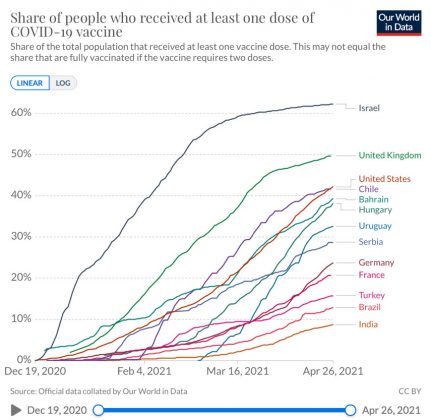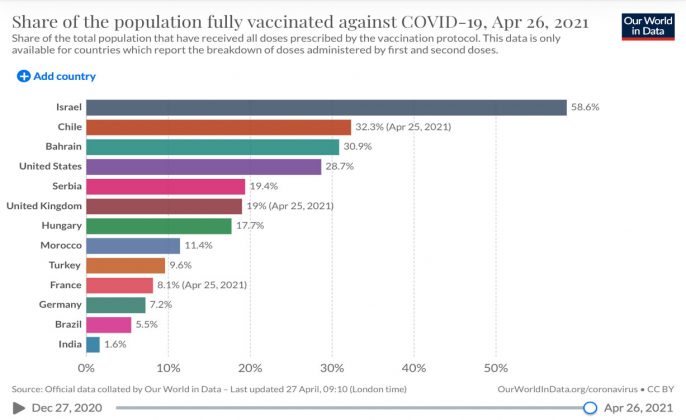#tdi_1_fe0 .td-doubleSlider-2 .td-item1 {
background: url(https://www.bworldonline.com/wp-content/uploads/2021/04/Guinigundo-chart1-042921-80×60.jpg) 0 0 no-repeat;
}
#tdi_1_fe0 .td-doubleSlider-2 .td-item2 {
background: url(https://www.bworldonline.com/wp-content/uploads/2021/04/Guinigundo-chart2-042921-80×60.jpg) 0 0 no-repeat;
}
Last Wednesday, the broadsheets reported the recommendation of the UP’s OCTA Research Group “to evaluate the surge capacity of densely populated Metro Manila as the threat of coronavirus disease (COVID-19) outbreak will remain while waiting for the arrival of the vaccines.” As we wrote this piece on Wednesday night, the Government extended the modified enhanced community quarantine (MECQ) in NCR, Bulacan, Cavite, Laguna and Rizal until May 14. This was a good decision.
India’s recent painful experience with the virus and its killer variants should serve as a cautionary tale to policy makers who faced yet again this seemingly difficult choice between life and jobs. There is really no trade-off because they are neither substitutes nor competitive. We need a healthy nation before we could even think of expanding business opportunities. At some point, we could attempt “dancing with the virus,” but we need the science of lockdown for proper guidance.
Worldometer’s latest update as of April 28 showed that of the world’s total cases of 149,414,444 some 17,997,267 came from India. That is a big 12%. India accounted for 201,187 of the world’s coronavirus deaths of 3,151,287 or 6.4%. The virus’ attack on the second most populous nation on earth peaked on April 25 with the highest ever daily infection of 354,880 with 2,809 deaths reported mostly in Maharashtra, Delhi, and Uttar Pradesh.
What makes India’s case truly crushing is its dismally low rate of vaccination compared to other economies. In turn, the early arrival of the limited vaccines might have contributed to the uptick in cases because people became more complacent. With limited vaccines available, Indians are now forced to protect themselves against the new variants. Otherwise, they face the grim prospects of treatment in overwhelmed public health facilities and a lack of oxygen supply.
In the east of Delhi, Reuters reported that a crematorium built funeral pyres in its parking lot to accommodate the burgeoning number of mortalities. A number of requests were also submitted to the authorities to fell trees in city parks to accommodate the need for isolation wards and hospital beds. India’s tattered healthcare system was simply stretched to the limit.
India is literally weeping.
At the same time, their speed of daily inoculation is slow. When it comes to full protection, or the share of the population with a full dosage of the jabs, India ranked only 13th. Faster vaccination allows herd immunity to happen and contains the spread of the virus and its possible mutation into a second or third more infectious variant.
What is clear is that India is neither in the same boat as the US which has a higher level of infection, nor China which is as almost as heavily populated. While the US’ total incidence was almost twice and its total deaths nearly three times India’s, the US has already administered the full dosage of the vaccines to 28.7% of its population. India managed to roll out the vaccines fully to only 1.6% of its population.
China can afford to be more careful with the vaccines to be administered to its population because it ranked only 95th in terms of infection. As of April 28, China’s incidence stood at only 90,622 against India’s nearly 18 million with only 4,636 deaths while India sustained more than 201,000 deaths.
How did India end up in this tragic situation?
A health company executive was quoted by The Economic Times saying “complacency led to unanticipated shortages of medicines, medical supplies and hospital beds.”
Indeed, during last winter in India, warnings of a second wave were ignored by the authorities even as new variants were identified as early as January. Daily cases totaled lower at some 10,000 but despite the increasing trend, the Government lifted mobility and business restrictions. Prime Minister Narendra Modi agreed at first to impose extensive lockdowns because India’s public health facilities could not handle the ever-increasing daily cases. He was also made to understand the pandemic had peaked in India and that they could start exporting medical oxygen and vaccines. Listening to its business constituents, the Government yielded and prematurely eased the restrictions. They peddled the idea that economic costs of lockdown could be staggering.
In fact, a Hindu festival was given the green light at which millions gathered in rivers and broke face masks and social distancing protocols. The Government likewise allowed packed political rallies for local elections — some Indians in the northern city of Lucknow could only sigh “we are dying here, and they are holding rallies there.”
As a result, there was a massive surge which built into the second wave. Many Indians equated the second wave with complacency + mixing + mass gatherings. Ramanan Laxminarayan of New Delhi’s Center for Disease Dynamics, Economics and Policy wisely commented that India did not need a new variant to trigger the upsurge.
This sounds familiar. Yes, caution against premature claims at excellence in pandemic management was likewise sounded in public halls of India but it seems no one was listening. As Laxminarayan said: “If we declare success too soon, open up everything, give up on public health, and not vaccinate rapidly, the new variants can be devastating.”
And the new variant did devastate India.
Photos of sick Indians lying in their personal cars near hospitals are simply heart-rending. Aljazeera described the whole spectacle as COVID-19 “swallowing Indians” as crematoriums are maxed beyond capacity. India by itself cannot make it.
A whole-of-nation approach would be inadequate to tackle the problem like India’s. No less than global support is necessary. Themselves hamstrung by their own share of the pandemic, several nations including the United States, the United Kingdom, and Germany are supporting India’s demand for medical oxygen and hospital beds. France pledged to supply India with substantial medical aid while Russia will be shipping both vaccines and the antiviral drug Remdesivir by May. If such a populous and globally strategic country like India fails to bounce back, herd immunity on a large scale would be elusive. India’s downfall could be a big downside risk to global growth and recovery.
Thus, Indian-American billionaire and Sun Microsystems co-founder Vinod Khosla, and other Indian-American tech executives at Google, IBM, and Microsoft are closely working with the US Congress to mount a huge assistance package for India.
Such international cooperation is absolutely urgent because given the recent dynamics of the virus, the closely watched health model from the University of Washington projects a staggering toll of nearly one million deaths in India by Aug. 1. With around 200,000 deaths in April, that means the pandemic onslaught would multiply five times in around three months.
In the Philippines, therefore, that decision upholding the OCTA Research Group’s recommendation was the right course of action. We find it unnecessary for the President to seek the public’s understanding for the right decision of the Government. An apology would be in order after the MECQ, if no vaccines are yet in sight, and those available are yet to be rolled out fast. We do not want to replicate India’s experience here, but the longer it takes to contain the virus, the fewer the options there are for keeping everyone safe.
Diwa C. Guinigundo is the former Deputy Governor for the Monetary and Economics Sector, the Bangko Sentral ng Pilipinas (BSP). He served the BSP for 41 years. In 2001-2003, he was Alternate Executive Director at the International Monetary Fund in Washington, DC. He is the senior pastor of the Fullness of Christ International Ministries in Mandaluyong.
Stay connected with us on social media platform for instant update click here to join our Twitter, & Facebook
We are now on Telegram. Click here to join our channel (@TechiUpdate) and stay updated with the latest Technology headlines.
For all the latest Business News Click Here
For the latest news and updates, follow us on Google News.


